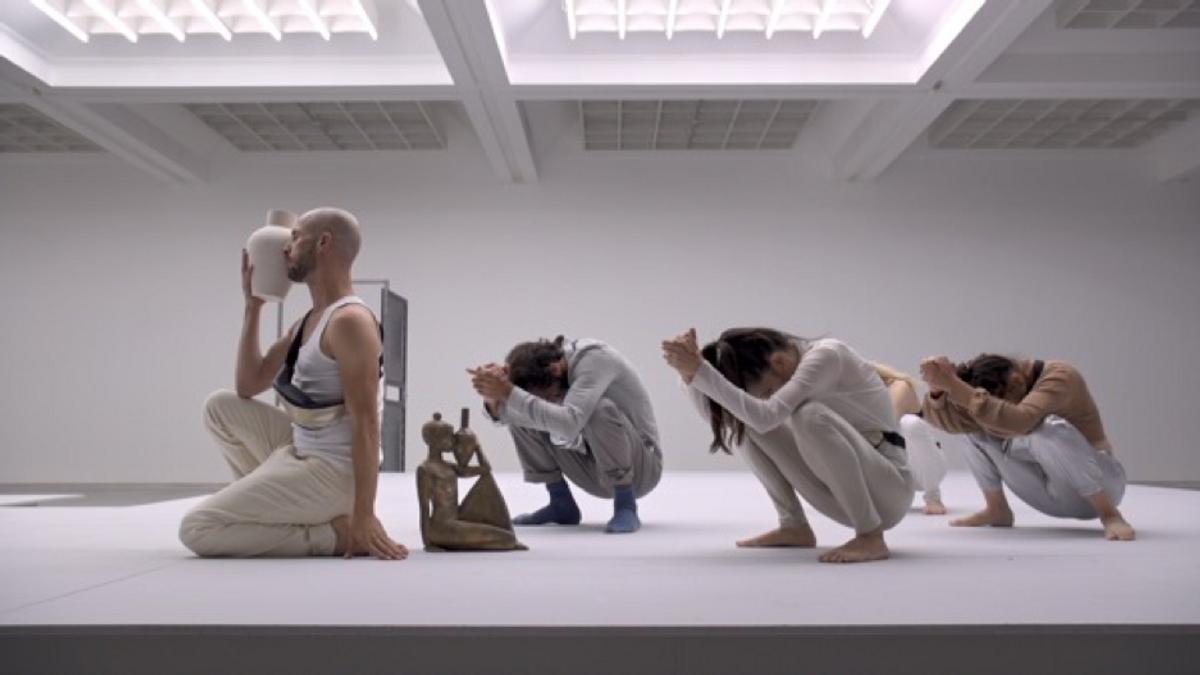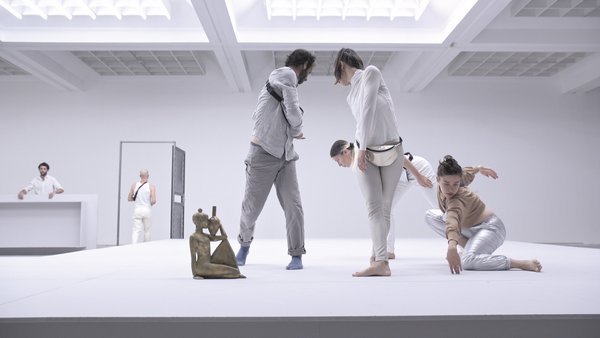From the Desk of…. Artist Michal Helfman

Michal Helfman, Edition of X, 2019, video still from Dear A.S.A/P, video installation at the Tel Aviv Museum of Art, 2020. Image credit: ASI Oren
In this interview, Michal Helfman wrote to us from Tel Aviv about her recent work that investigates the notion of vulnerability, and reimagines how artworks can be shared with the public.
This interview was conducted in May 2020 as part of Artis’ series, From the Desk of…. In this series, we check in with artists, curators, and collectors about their recent projects, reflections on social distancing and quarantine, due to the COVID-19 pandemic, as well as how they are practicing, experiencing, and engaging with art.

Images (left to right): Michal Helfman, Edition of X, 2019, video still from Dear A.S.A/P, video installation at the Tel Aviv Museum of Art, 2020. Image credit: ASI Oren; Michal Helfman, Dear ASA/P, installation view at the Tel Aviv Museum of Art, curtains, lighted hand drawn sign, 2020. Exhibition Curator: Anat Danon Sivan; Curatorial Assistant: Amit Shema. Image credits: Elad Sarig.
Tell us about a project you’re working on now. What kind of research are you doing to develop this project?
My solo exhibition at the Tel Aviv Museum of Art, Dear A.S.A/P , was supposed to open on April 2, 2020, but is on hold because of museum closures due to COVID-19. At the heart of the exhibition is a video installation that imagines a reality where artists are denied the freedom to physically move locations or present their own work. There is a mechanism that mediates and transmits artists’ work to the public in new, alternative ways.
The video project features the Edition of X (EOX)®* , a group I founded two years ago that liaises between art institutions; the public; artists whose freedom of physical movement and action are limited due to political restrictions; and their artwork. The EOX is a collective of professionals working across artistic disciplines and living in various locations. Artists who experience physical or political restrictions are invited to send members of the EOX instructions for aesthetic gestures or actions, which are then interpreted and presented to the public on the artist’s behalf. Through the transmission process, the artwork is exchanged across media, geographies, and cultures. The final form of the work is the result of a translation process, inclusive of “failures”.
Given the COVID-19 pandemic, the situation presented in Dear ASA/P has become a global reality. As is the case for many exhibitions around the world, my project, Dear A.S.A/P , is installed in the museum and ready to be presented, but it cannot be seen in person because the museum is closed. Paradoxically, this fulfills the experience that is proposed in the video.
Has your practice shifted in response to social distancing and quarantine regulations?
Uncertainty and vulnerability* are symptoms of our time. Even before the pandemic, we were already experiencing degrees of economic, political, and environmental instabilities. This is the social context into which the EOX was inaugurated. The experience of our unstable global systems that rapidly reach their full capacities, led us to reformulate how we organize, and, subsequently, to the creation of the EOX. We named this new way of organizing a Connective®* : a chain of individuals, with an independent practice, who are summoned to collaborate when needed.
The EOX is invested in research on the subject of vulnerability. EOX believes that vulnerability*, which is felt by all of us, can be the entry point through which society yields new social sensitivities, values, and agencies. Understanding notions of uncertainty and vulnerability are essential for any solution to our current crisis. The EOX believes that these sensibilities can be practiced through art.

Michal Helfman, Dear ASA/P, installation view at the Tel Aviv Museum of Art, wooden stage segments, framed oil painted drawings (150x170cm), bronze sculpture (30x40x15cm), 2020. Image credits: Elad Sarig.
Is there anything, in particular, that you miss from life before social distancing?
These days, I painfully miss the presence of art. We can’t physically access institutions to see art, or fully engage with works of art, dance, theater, and so forth. In this situation, our collective imagination is limited to that of politicians and scientists. I think that in these times, we urgently need art to imagine and act in alternative, generative, and transformative ways.
How are you staying connected to friends, family, and colleagues? What does community and solidarity mean to you nowadays?
As a faculty member at the Bezalel Academy of Art and Design, I feel responsible for my students. The art department is a supportive and vibrant community. We reflect together on present events and the role of art in times of a crisis. It’s a good time to sustain an art practice that involves listening to ourselves, to one another, and to the moment.
*GLOSSARY OF TERMS PROVIDED BY THE ARTIST
Edition of X (EOX)®
An international group of cultural workers that liaise among institutions; the public; artists whose freedom of physical movement and action are limited due to political restrictions; and their artwork.
Transmission An action that the EOX members provide to artists whose freedom of movement and action is limited due to political restrictions, the opportunity to present their work publicly. The transmission is based on a three-stage process.
- An artist that is invited to exhibit in an art institution sends verbal instructions for aesthetic gestures or actions to the EOX members, via an encrypted email service.
- EOX members interpret the instructions in a performative manner. They perform the gesture to the curator, or arts professional, at the institution where the work will be presented.
- The representative from the institution translates this encounter into the exhibition, along with the EOX.
The transmission is a service to the artists who are unable to execute their work due to political limitations. The transmission involves stages of interpretations from various individuals through different media in order to assert the broken, disrupted reality artists and the EOX members work in, and respond to.
Connective®
A chain of individuals, each with an independent practice, who are summoned to collaborate on a need basis. Unlike a collective, connective members do not share a time, space, or economy. Rather, the connective is formed as a temporary network, which matches its members’ availability and interest in a specific mission. Once a mission is completed, each member returns to their independent practice. The connective draws inspiration from the organizational structure of “sleeper cells” that respond to the principle of “centralization of decision and decentralization of execution.” This structure implies a transmission between an electing head (the artist whose freedom of action and movement is limited) and an executing body (EOX); the head and the body change places from one mission to the next.
Vulnerability
“To the untrained eye it may seem as if your performance has not changed. But you knew that from this time on, you will position yourself in relation to the shadow and not in relation to the light. The edges of your shadow and the darkness that surrounds you touch each other and seem to merge.”
(from the video Dear A.S.A/P, 2019)
Vulnerability is a symptom of our time. Economic and political crises, the dissolution of imaginary timetables of past generations, and unpredictable futures are the condition of life for many. People increasingly find themselves outside a place to which they belong, without protection and support. They know their lives and the lives of their loved ones might be swept away at any moment by forces that they do not necessarily recognize.
In this context, vulnerability becomes a new starting point for understanding human social and moral existence. Thus, on the one hand, vulnerability is existential, and on the other hand, vulnerability is the product of social and historical constructs. If we accept vulnerability as a condition of contemporary life that is both a signifier of social injustices and the foundation for human connectivity, we might consider it as a system of links through which emotions, forces, and actions can flow. The connective is the form of political activity in a world of vulnerability.
